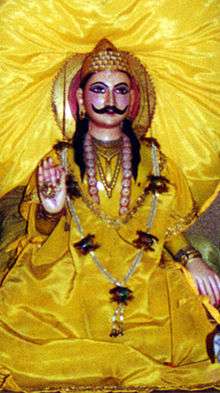Sant Charandas

Sant Charandas was a major Hindu religious teacher in Delhi during the eighteenth century.[1]
Biography
First called Ranjit Singh, Charandas was born in Derha, near Alwar, in Rajasthan in 1703. His family belonged to the baniyar caste (merchant class).
While still a child, Ranjit claimed to have had a vision of the divine sage Shukdev, the perpetually youthful son of Vyasa.
Following the disappearance of his father, Murlidhar, when he was about twelve, Ranjit and his mother moved to live with relatives in Delhi.
As a teenager, Ranjit spent periods meditating in the forest. He claimed to have met Shukdev again at the age of nineteen, and that Shukdev formally initiated him into the ascetic life, giving him the name Shyam Charandas - "servant of the feet of Krishna".
Charandas then passed some fourteen years in isolation, practising yoga and devotional worship, living in a cave in the wilderness outside Delhi.
In 1738, Charandas began accepting followers in Delhi and continued teaching there for the rest of his life, with periodical trips into the countryside.
Charandas died in 1782.[1]
Teachings
Charandas is the author of around twenty works.[2] Many of these are in verse and deal with aspects of devotion, particularly relating to the worship of Krishna.[3] He is credited by his followers with a vision of Krishna while on pilgrimage to Vraj in mid-life, as well as a further meeting with Shukdev at the same time.[1]
He wrote commentaries on various Upanishads, particularly the Katha Upanishad,[3] and on specific yoga practices, especially Pranayama, control of the breath.[4]
A member of the Sant mystical tradition,[5] Charandas's teachings draw on a wide range of sources and emphasise the nearness of the Divine to each person, the need to follow a guru, the importance of sharing in a community of like-minded believers not dependent on caste (Satsang), and the value of leading a strict moral life.
Two of his major disciples, Sahajo Bai and Daya Bai, both women, are also famous for their poetry.[6][7][8]
Sources
- 1 2 3 Gold, D. (1987). The Lord as Guru: Hini Sants in the Northern Indian Tradition. New York: Oxford University Press.
- ↑ Sukla, S (1995). Carandas Sampraday aur uska Sahitya. Varanasi: Kali Prakasan. pp. 132–161.
- 1 2 Charandas (2001), Bhaktisagar, Mumbai: Khemraj Srikrishnadas Prakashan
- ↑ Charandas, Astangayogavarnan [Astanga Yoga of Saint Charandas], Translated Om Prakash Tiwari (1983), Lonavla: Kaivalyadham Press
- ↑ Schomer, K; McLeod, W (1987). The Sants. Delhi: Motilal Banarsidass.
- ↑ Bali, Sahajo (2001) [1903]. Sahaj Prakash. Translated by Harry Aveling; Sudha Joshi. Delhi: Motilal Banarsidass. Allahabada: Belvedere Press.
- ↑ Bai, Daya (2005) [1908], Daya Bai ki Bani [The Songs of Daya Bai], translated by Harry Aveling; Peter Friedlander, Delhi: Prestige Books, Allahabada, Delhi: Belvedere Press
- ↑ McGregor, R.S. (1984). Hindi Literature of the nineteenth and early twentieth centuries (Vol. 8 Part 1). Verlag: Otto Harrassowitz.
References
- Charandas (2014), Bhaktipadarth [The Treasury of Devotion], translated by Peter Friedlander; Harry Aveling, Delhi: Prestige Books
- Osho Rajneesh (1978), Nahin Sanjh Nahin Bhor, Pune: Rajneesh Foundation
- Sahajo Bai (2001), Sahaj Prakash [The Brightness of Simplicity], translated by Harry Aveling; Sudha Joshi, Delhi: Motilal Banarsidass, Allahabada: Belvedere Press